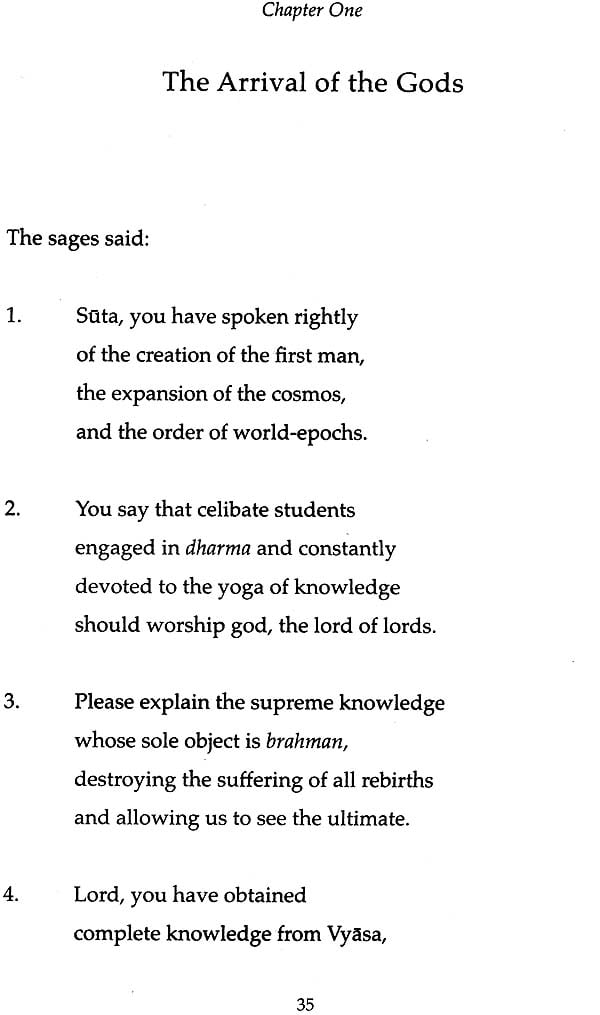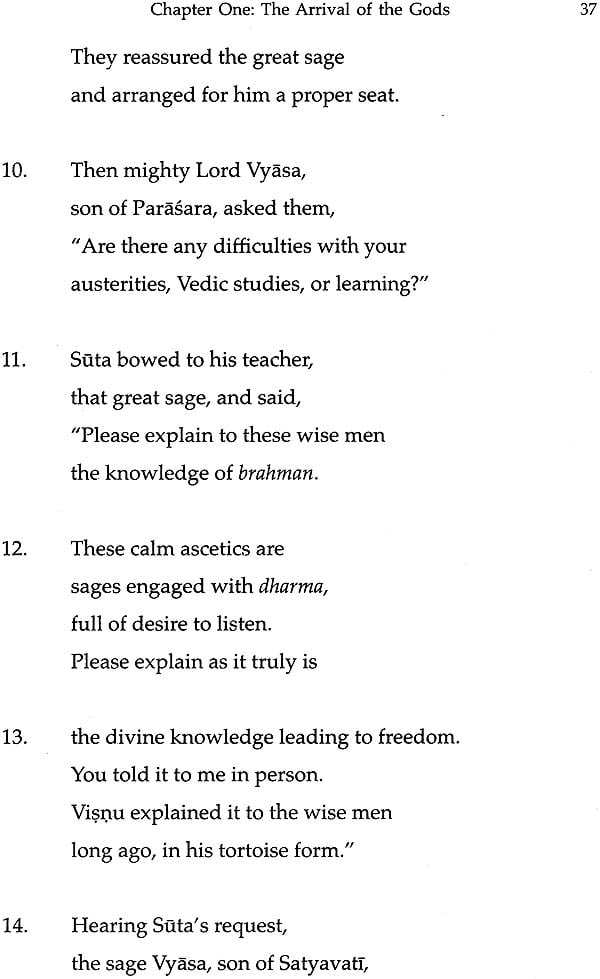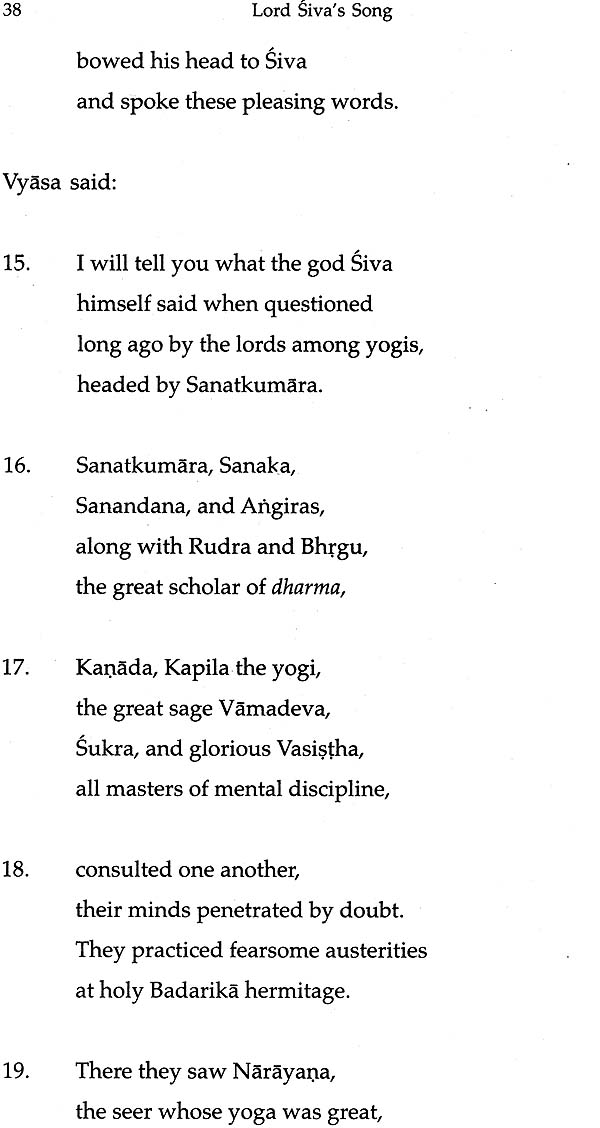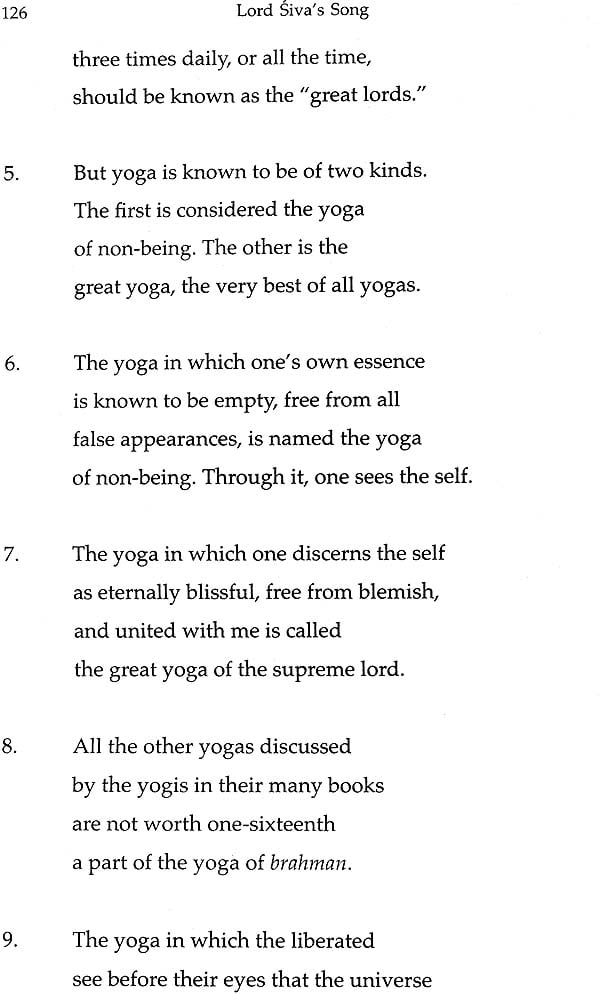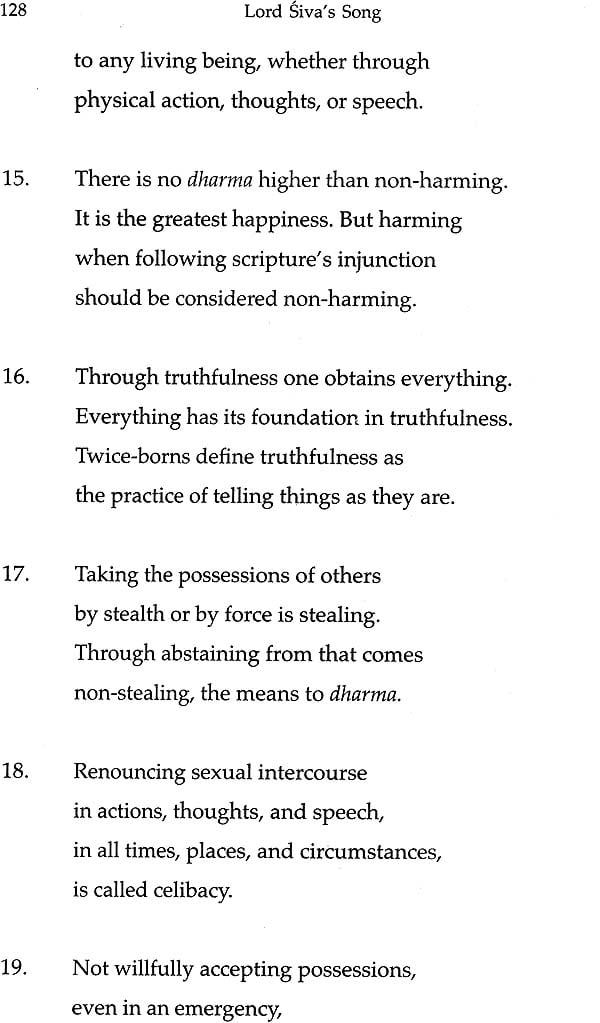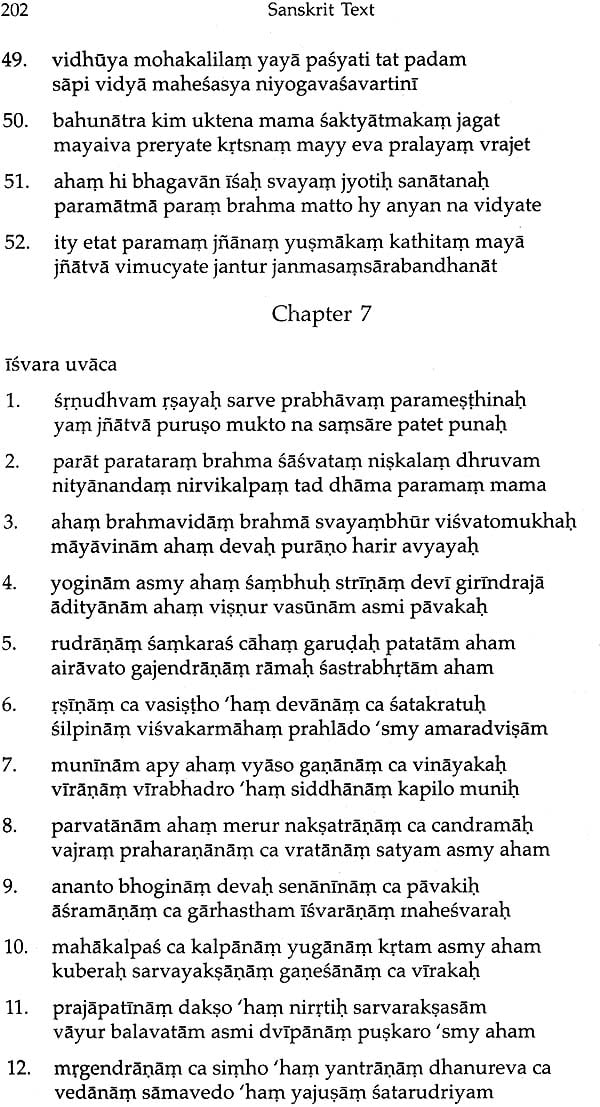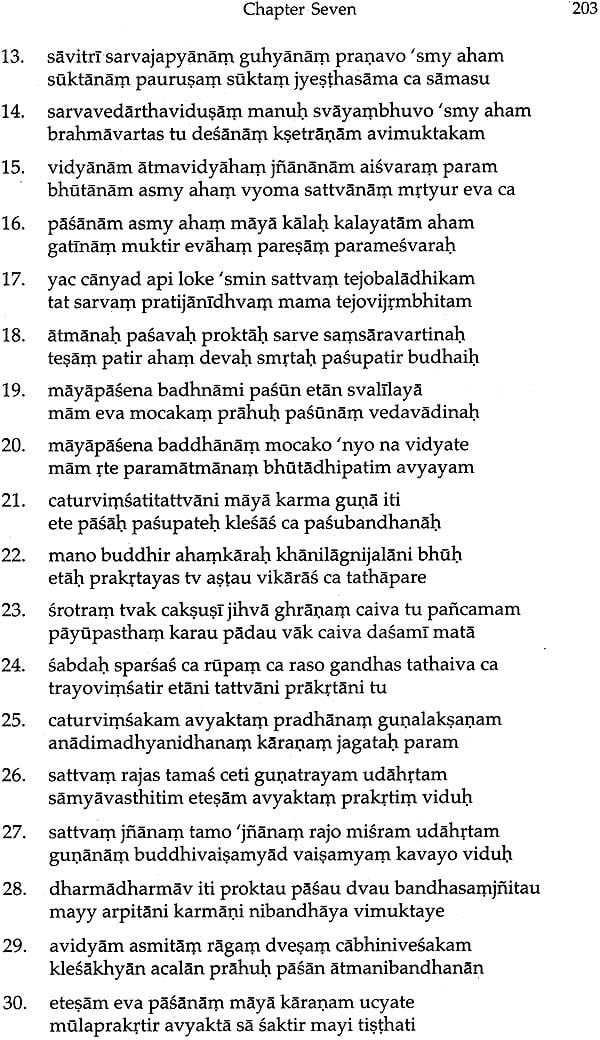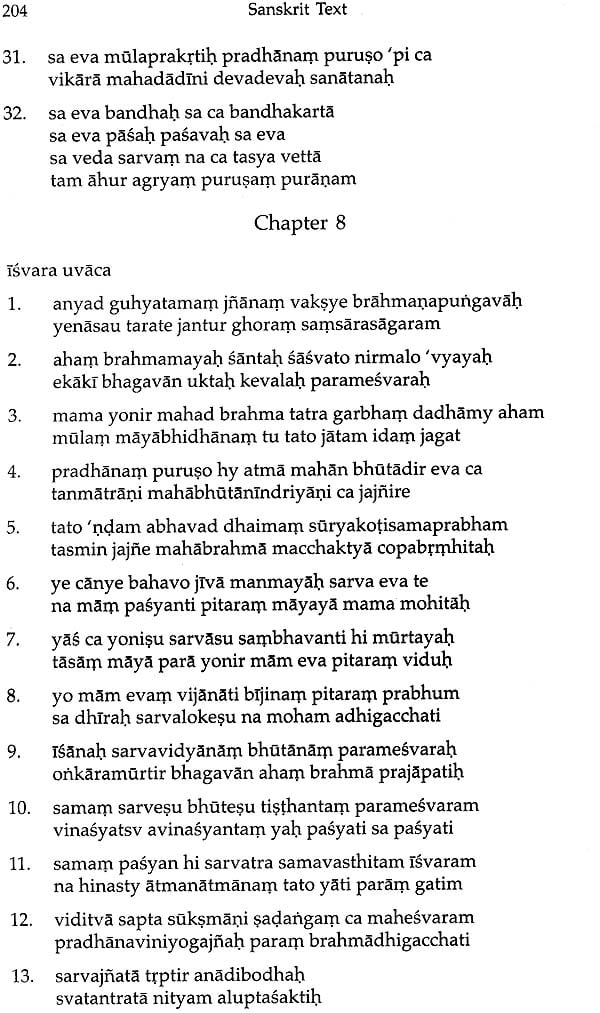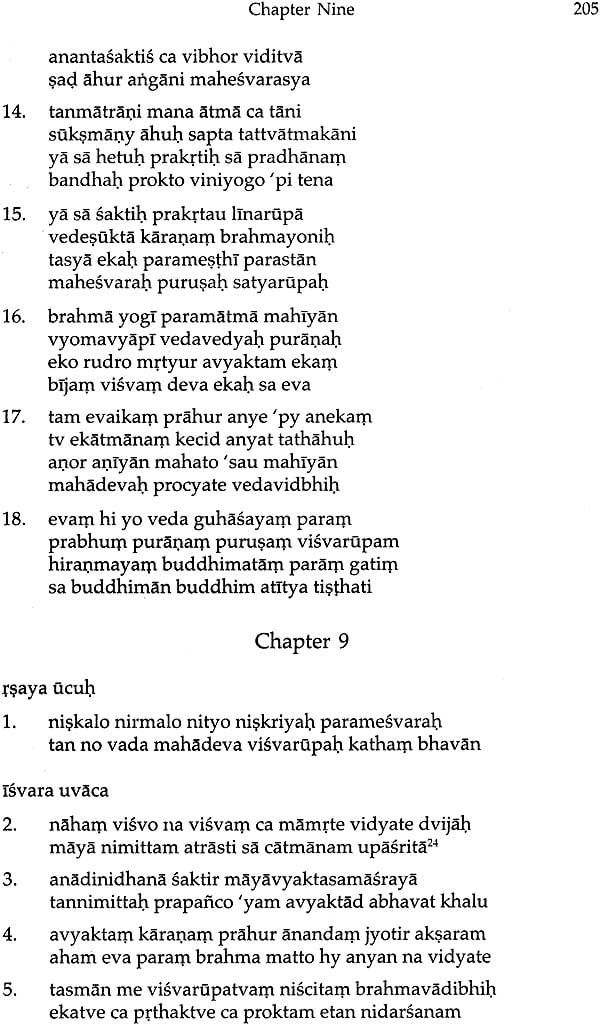
Lord Siva's Song (The Isvara Gita)
Book Specification
| Item Code: | NAN023 |
| Author: | Andrew J. Nicholson |
| Publisher: | MUNSHIRAM MANOHARLAL PUBLISHERS PVT LTD |
| Edition: | 2016 |
| ISBN: | 9788121513036 |
| Pages: | 245 |
| Cover: | Hardcover |
| Other Details | 9.5 inch x 6.5 inch |
| Weight | 510 gm |
Book Description
While the Bhagavad Gita is an acknowledged treasure of world spiritual literature, few people know a parallel text, the Isvara Gita. This lesser- known work is also dedicated to a god, but in this case it is Siva, rather than krsna, who is depicted as the omniscient creator of the world. Andrew J. Nicholson’s Lord Siva’s Song makes this text available in English in an accessible new translation. A work of poetry and philosophy, the Isvara Gita builds on the insights of Patanjali’s Yoga Sutra and foreshadows later developments in tantric yoga. It deals with the pluralistic religious environment of early medieval India through an exploration of the relationship between the gods Siva and Visnu. The work condemns sectarianism and violence, and provides a strategy for accommodating conflicting religious claims in its own day and in our own.
Andrew J. Nicholson is Associate Professor of Hinduism and Indian Intellectual History at the State University of New York, Stony Brook. His primary area of research is Indian Philosophy and intellectual History, particularly medieval Vedanta and theistic yoga philosophies and their influence in the modern world. His first book, Unifying Hinduism: Philosophy and Identity in Indian Intellectual History and was awarded Best First Book in the History of Religions by the American Academy of Religion. This book is Professor Nicholson’s second work and is an annotated translation of an eighth century Pasupata Yoga text.
The Isvara Gita ("Lord Siva's Song") is a philosophical poem that conveys the teachings of the Pasupatas, a group of Siva worshippers who would have a profound and lasting influence on the development of Hinduism. Since its composition in the eighth century CE, it has been an inspiration to generations of philosophers, devotees, and yogis in India. Like its famous predecessor, the Bhagavad Gita ("Song of Lord Krsna"), it goes beyond mere philosophical theory to describe a regimen of spiritual exercises to achieve self-transcendence and absolute freedom. These spiritual exercises, the "Pasupata Yoga," are a regimen of ethical discipline, breath control, physical postures, and mental concentration through which the yogi attains divine knowledge, power, and liberation. Pasupatas are not content just to know god. The ultimate goal of Pasupata Yoga is to become god-to attain Lord Siva's majestic power and wisdom in this very lifetime through mental absorption and union with him, the Lord of Yoga.
The proliferation of many different practices in the globalized yoga of the 20th and 21st centuries has led modem yogis to great uncertainty about what the final goal of yoga practice is: Is it stress relief? Peace of mind? Self-actualization? Nirvana? Many teachers today describe Patanjali's Yoga Sutras, an influential text compiled between the second and fifth centuries CE, as the authorities set of guidelines for yoga practice. But examination of Patanjali's work reveals that many of the central ideas and practices of yoga as understood in later times are absent. One notable difference is Patanjali's relative lack of interest in physical postures (asanas), the main focus of practice for many modem yogis. Another surprise for some Hindus might be the place of god (isvara) in Patanjali's Yoga Sutras. Although often described as the "classical Hindu" yoga, worship of and meditation on god is according to Patanjali a mere preliminary practice to the highest form of yoga.' This contrasts with the understanding of most Hindus, for whom god-absorption is the highest yogic practice.
The Isvara Gita, "Lord Siva's Song," shows some influence from Patanjali's eight-limbed (astanga) yoga. According to this later text, however, Patanjali's highest form of mental absorption (samadhi) is a lower yoga, below absorption in god. The Isvara Gita also shares many concepts and themes with the famous Bhagavad Gita, composed some six centuries earlier.' The most obvious difference between these two texts is the god who presents their teachings. In the Bhagavad Gita, it is Krsna, in disguise as a charioteer, who instructs the great warrior Arjuna on the subtleties of philosophy and sacred duty (dharma). In the Isvara Gita it is Siva as Pasupati, Master of Beasts, who instructs a group of sages about the highest truth and the means to realize it through the practice of yoga. Siva says that he himself is supreme, the source of creation for all other gods, and the ultimate focus of yogic concentration. In the popular imagination and especially among non- Hindus, Siva is regarded as the god of destruction. However, according to the Pasupatas who composed the Isvara Gita, he is something much more: the creator of the universe and the ultimate source of worldly bondage and liberation.
The Historical Background of the Isvara Gita
The earliest Hindu holy texts are the Vedas, composed in Sanskrit beginning in approximately 1500 BCE. For many Hindus, the Vedas are the absolute scriptural authority. According to traditional interpretation, the Vedas are eternal and beyond human authorship, received by ancient seers who spoke and memorized the words of the Vedas. Indeed, the word "scripture" is misleading insofar as the Vedas were oral texts not written down until hundreds of years after their composition. Scholars of the Vedas made a fundamental distinction between the eternal Vedas and other texts that were composed by human authors. In this second category are included the Bhagavad Gita and Isvara Gita, both attributed to the sage Vyasa. Although considered an omniscient seer, Vyasa's texts and those composed by other great sages were not considered to have the same level of authority as the eternal Vedas. They were labeled "traditional" (smrti) texts rather than the "revealed" (sruti) texts that make up the Vedas. The gods Siva and Visnu, prominently featured in Isvara Gita, are different than those emphasized in most of the Vedas. Yet an early form of Siva is present in some form in the Vedas, known by another name, Rudra, "the roarer." Later parts of the Vedas, known as the Upanisads, show evidence of an increasing reverence for Rudra-Siva. The Svetasvatara Upanisad (circa third century BCE) describes Rudra as the supreme being and creator of the entire world. The themes of this monotheistic text went on to have a great influence on later religious literature, including the Bhagavad Gita and Isvara Gita.
The Puranas, a voluminous group of texts whose composition began around the fourth century CE, are the source of much of the mythology surrounding the god Siva that has inspired Hindus in the medieval and modern periods. It is in the Puranas that we find the majority of texts known as Gitas, "songs." Like the Hindu epics the Mahabharata and the Ramayana, the Puranas are "traditional," not "revealed." All these Puranas were regarded as the works of Vyasa, an author of superhuman productivity, if we take these stories of authorship as historical fact. The Puranas are sometimes stereotyped as "mythological" texts. They certainly are a rich source of Hindu mythology, but they are also much more. Like the Mahabharata, the Puranas are a vast repository of wisdom, containing sections on philosophy, theology, law, astrology, ritual theory, cosmology, and political science, usually combined in ways that defy tidy classification. The Isvara ona is itself a small section of one of these Puranas, the Kurma Purana ("Purana of the Tortoise Incarnation").
The Puranas frequently present a trio of divine forms (the trimurti), each form with a specific task: The god Brahma is responsible for the world's creation, Visnu for the world's preservation, and Siva for the world's destruction. However, this formulation obscures the monotheistic orientation of many sections of the Puranas, The Isvara Gita teaches that although it may appear that Brahma and Visnu do their work independently from Siva, the wise know that all the other gods are controlled by, and parts of a single supreme deity. This single supreme deity is Lord Siva." Siva is the one absolute god, and other gods mere aspects of the One. Like the Bhagavad Gita and the Svetasvatara Upanisad, the Isvara Gita is not a polytheistic text, strictly speaking. Yet neither is it a monotheistic text in the same sense as the Bible or the Qur'an. In the monotheism of the Isvara Gita, the many gods are real and have real power in the world. But all their power is derived from the One, the supreme Siva.
The Isvara Gita, although influential for medieval Hindus, was just one of the many sections labeled "Gitas" from the Puranas. Disregarded by most modern scholars of Hindu mythology for their philosophical focus, these Gitas also have been ignored by modern historians of Indian philosophy who do not usually think of the Puranas as quite properly philosophical. But premodern philosophers in India did not share this attitude toward the Puranas, The authors of the five Sanskrit commentaries on the Isvara Gita that have survived to the present day take this text every bit as seriously as the Bhagavad Gita. One even suggests the Bhagavad Gita and Isvara Gita are in essence the same teaching." It makes sense that these Hindu philosophers would have treated the Isvara Gita, and the Puranas in general, with such reverence. If the sage Vyasa composed the Mahabharata and all of the many Puranas, then the Isvara Gita and the Bhagavad Gita must present the same philosophy. How could an omniscient sage change his mind or contradict himself?
In the modern era, influential Hindu reformers such as Gandhi, Aurobindo, and Radhakrishnan have departed from premodern attitudes about the Vedas' authorship and the omniscience of the author(s) of the Puranas. It is now widely accepted by Hindus and non-Hindus alike that the Puranas, the Mahabharata, and the Ramayana were each composed by more than one person over the course of several centuries, and that some of the thematic shifts we see within these texts are due to shifts in authorship. Yet if the Mahabharata and the Puranas were not all composed by a single author, and were instead composed over the course of many centuries, who were the true authors and compilers of these texts? How should we approach the Puranas' frequent repetitions of themes and stories found in the Mahabharata, in particular? Are the Puranas muddled, superstitious texts, products of a later degenerate phase of Hinduism? Intertextuality and Hinduism?
The Isvara Gita, the Bhagavad Gila, and the Yoga Sutras
The Isvara Gita has been dismissed by some in the modern period because of its apparent borrowings from the Bhagavad Gita. In the words of the 20th-century Sanskritist Franklin Edgerton, the Isvara Gita is an "imitative performance," "pale and lifeless" in comparison to its original." Many Western Indologists and modern Hindu reformers shared this assessment of the Isvara Gita, and of the Puranas in general. One powerful example of modern anti-Puranic attitudes comes from Swami Dayananda Saraswati (1824-1883), founder of the influential Arya Samaj ("Society of Nobles") reform movement. Dayananda opposed idolatry in all its forms and saw the Vedas as preaching a rational worship of a formless and nameless ultimate God. Although some Hindus who believe in a God beyond forms might maintain that idol-worship is a "ladder" whereby the uneducated are able to approach the absolute reality, Dayananda emphatically disagreed. According to him:
The method of worshipping through idols was introduced by the tantras and puranas .... Idol-worship is not a ladder. It is a big ditch, by falling into which man is smashed to pieces. He can never come out of it and is sure to remain there till he dies .... Nobody has ever become learned by the worship of idols. All idolators remain ignorant till death overcomes them and terminates their unsuccessful career.
Dayananda maintained that the Puranas were the not true works of Vyasa, but rather works of later authors "in the name of Vyasa ... full of ridiculous and credulous stories." Although contemporary scholars would agree with Dayananda's assessment that the Puranas were not all composed by a single author, many would argue that Dayananda sells the Puranas short. Besides providing immense amounts of data for historians who wish to understand the development of medieval Hinduism, the Puranas are also a vast repository of wisdom, a continuation of the insights of the Vedas and epics.
The Bhagavad Gita, a section of the epic Mahabharata, has been considered by Gandhi and many other modern Hindus as the closest equivalent that Hinduism has to a Bible. Its fame has been so overpowering that many Hindus themselves are unaware that it is only one among dozens of texts in Sanskrit known as "Gitas" or "songs."!" These Gitas are philosophical dialogues written in verse, and often involve a conversation between an omniscient deity and one or more human beings. The themes of these other Gita often overlap with the Bhagavad Gita, especially in their focus on bhakti (devotion to god) and on the practice of yoga. But they were written after the Bhagavad Gita, often by many centuries, and their teachings mark further elaborations of the themes found in earlier texts. Some medieval Gitas present teachings of tantric yoga, including such nowfamiliar ideas as cosmic union of male and female principles represented by the ascent of the kundalint serpent through the subtle energy centers known as cakras. The Isvara Gita stands at an important transitional stage before the widespread influence of tantra but after the "classical" yoga of Patanjali. It shows the unmistakable influence of Patanjali's Yoga Sutras in its elaboration of the eightfold (astanga) yoga, yet it goes beyond him. In chapter 11, the Isvara Gita teaches that the "aloneness" (kaivalya) presented by Patanjali as the highest goal is only a preliminary step on the way to the highest yoga, the union of the individual self with Lord Siva.
| Acknowledgments | ix | |
| Introduction | 1 | |
|
|
||
| 1 | The Arrival of the Gods | 35 |
| 2 | The Changeless Self | 47 |
| 3 | The Unmanifest Lord | 59 |
| 4 | The God of Gods | 65 |
| 5 | The Lord's Dance | 73 |
| 6 | The Glory of Lord Siva | 87 |
| 7 | The Master of Beasts | 99 |
| 8 | The Hidden Lord | 107 |
| 9 | Brahman's Powers | 113 |
| 10 | Brahman and the Lord | 119 |
| 11 | The Highest Yoga | 125 |
| Commentarial Notes | 155 | |
| Sanskrit Text | 185 | |
| List of Concordances | 219 | |
| Glossary of Sanskrit Names and Terms | 223 | |
| Bibliography | 233 |
